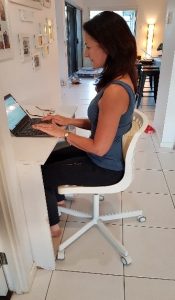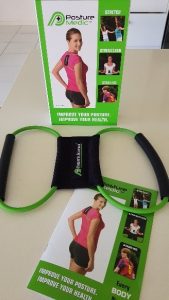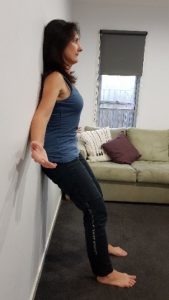Are you experiencing discomfort, burning or pain across your upper back or shoulder blades, a sore neck, tension headaches or even shoulder pain? If you are you should consider a posture check. Posture is so important, not only does it have an aesthetic appeal, but it makes all the difference to preventing and correcting spinal problems. Most of us already have a bit of posture related discomfort, it seems to be par for the course in our busy, yet more sedentary lifestyles. And if you are a desk user, you are more predisposed than anyone else.
The structure of the spine.
The spine is a series of small bones stacked on top of one another and separated by shock absorbing cushions, the discs. This beautiful design allows small movements at each segment to create large, functional movements of the whole. It is efficient and effective. Between each of the small bones are a pair of joints, the facet joints, that allow the vertebra to articulate or glide with the vertebrae above and below. The whole structure is supported by ligaments and muscles giving strength and stability. And of course, let’s not forget the structural importance of the spinal column, its function is also to house and protect the spinal cord and nerves as they extend from the spinal cord and travel throughout the body. You will agree, it’ pretty important to keep it healthy.
 What then is good posture?
What then is good posture?
The ability to keep your spine positioned in a way that places the least amount of stress on the muscular and ligamental structures. When your muscles are in balance, this bony stack lines up with little risk of creating undue pressure through its complex joint system and allows the nerves to glide freely.
Does it need to be complicated?
No not at all. Ideally you want your posture to be an automatic function of your body, however, it might take work to find muscle balance and discipline to maintain it.
What needs to happen to improve your posture?
Your environment –
Where possible set your environment up to support your posture, this is especially true if you are tied to a desk for long periods of time in the day.
Simple rules:
- Sit with your bottom back in the chair.
- Place your feet on the floor or on a raised block if you are vertically challenged.
- A small lumbar support in the small of your back helps to maintain a normal curve in the lower spine, bringing the rest of the spine into balance.
- Your elbows should be close to a 90-degree bend, with wrists or forearms rested on your desk.
- Your bottom should be slightly higher than your knees to tilt your pelvis forward.
- Have regular breaks where you get up and move away from your desk.
Strengthen your core stabilisers
These refers to the deepest layer of abdominal muscles that wrap around your torso from left to right. This will act like a natural corset, propping you up from the pelvis and protecting the spine. Speak to your physiotherapist about the right type of core stability exercises for you; it will depend on your level of fitness or conditioning and if you already have an injury
Simple posture exercises
There are a huge variety of exercises you could do, that would support good posture and they vary in complexity. Once again, your physiotherapist will be able to find the best fit for you and will show you how to progress them appropriately. But if you want a few, simple, quick exercise that will improve your posture, here is a good place to start.
Thoracic spine extension.
Lie on your back with a tightly rolled hand towel placed along the length of your spine. Have your knees bent up comfortably and the small of your back gently pressed into the floor. Gently tuck your chin in, lengthening out your spine. Keep your elbows about 45 degrees away from your trunk, flexed and hands pointing to the sky. Gently press your shoulder blades down into the floor on either side of the towel. Hold for 10 sec, repeat 10 times.

Spot light
Sit on the edge of a bed or a chair. Imagine a spot light on your breast bone; without pulling your shoulders back, guide your spot light up to shine directly in front of you. You will notice this movement comes from a central spot between your shoulder blades. Keep your shoulders relaxed and be careful not to arch your lower back.
Hold for 10 sec and repeat 10 times.
Standing thoracic spine extensions
Stand up against a wall, walk your feet forward slightly and slide yourself down so that you have a small bend in the knees. Tilt your pelvis so that the small of your back presses gently into the wall. It is important that you hold this position. You will notice that your chin automatically tucks in slightly. Now place your arms out to the side with your palms facing out. Inhale and as you exhale, gently press your arms into the wall, while turning the palms up (so there is some rotation). You will feel this between your shoulder blades and your chest will feel open in the front.
Repeat 10 times.
The posture medic
The Posture Medic is one of many postural aids that can help you achieve the results your desire. Its simple design that allows you to get a feel for the correct posture as you wear it but also becomes the apparatus you can use to both stretch tight muscles and strengthen weaker muscles. When you wear the posture medic it opens your chest to correct the slouching posture, relieves tension across the shoulders and corrects your chin position. Its main aim is to provide biofeedback to your body, reminding you to engage the correct muscles required to maintain good posture. It is definitely not a substitute for your own muscle action and therefore is not a brace to wear for extended periods of time. The aim is to wear it for designated periods of time, to reposition your back, remind your body of good positioning and encouraging active participation in the strength training process. The devise is also used to assist stretching and provide resistance for strengthening exercises. The Posture Medic comes with a brochure that outlines specific exercises and a sage guide. It is colour coded for size and comes in two strengths. If you would like to purchase a Posture Medic, contact me at Sunshine Coast Health Services.


